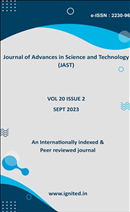Synthesis, Characterization and Antimicrobial Activity of Homonuclear Cu(II) and Ni(II) Schiff Base Complexes
DOI:
https://doi.org/10.29070/cp5vsm97Keywords:
Schiff base, Homonuclear complexes, BSA/DNA–binding, Cytotoxicity, Metal complex Cu(II) and Ni(II)Abstract
The current study aimed to synthesise, characterise, and investigate the antimicrobial activity of homonuclear Cu(II) and Ni(II) Schiff base complexes. Homonuclear Schiff Base Complexes chelates of Cu(II) and Ni(II) were synthesised. It appears that the complex is a potential metallo-ligand. It forms binuclear complexes when it reacts with two different metal salts, Ni and Cu. Using a Schiff base ligand made from 4-chloro-o-phenylenediamine and 3,5-dichloro-2-hydroxyacetophenone, the homo and hetero binuclear oxygen bridging Cu(II) and Ni(II) complexes were synthesized. Numerous common physicochemical methods, including elemental analysis, spectroscopic, thermal, cyclic voltammetry, and magnetic moment tests, have been used to characterise the synthesised complexes. For the mono- and binuclear compound of Cu(II) & Ni(II), spectral analysis reveals square planer shape. The antibacterial data indicates that the homo-binuclear copper complex is more active than the other mono- and binuclear complexes. Research has been done on the Schiff base and its complexes' anticancer properties.
Downloads
References
H. Schiff, "Mittheilungen aus dem Universitats laboratorium in Pisa: Eine neue Reihe Organischer Basen," Annalen der Chemie und Pharmacie, vol. 131, no. 1, pp. 118-119, 1864.
B. S. Sathe, E. Jayachandran, V. A. Jagtap, and G. M. Sreenivasa, "Synthesis and antibacterial, antifungal activity of novel analogs of fluorobenzothiazole Schiff bases, Journal of Chemical and Pharmaceutical Sciences, vol. 3, no. 4, pp. 216-217, 2010.
S. M. Sondhi, N. Singh, A. Kumar, O. Lozach, and L. Meijer, "Synthesis, anti inflammatory, analgesic and kinase (CDK-1,CDK-5 and GSK-3) inhibition activity evaluation of benz-imidazole/benzoxazole derivatives and some schiff's bases," Bioorganic & Medicinal Chemistry, vol. 14, no. 11, pp. 3758–3765, 2006.
R. M. Mishra, S. Pandey, and R. Saxena, "Homozygous haemoglobin D with alpha thalassemia: case report," Open Hematology Journal, vol. 2, pp. 1-4, 2011.
C. Ajit Kumar and S. N. Pandeya, "Synthesis and anticon-vulsant activity (chemoshock) of schiff and mannich bases of isatin derivatives with 2-amino pyridine (mechanism of action)," International Journal of PharmTech Research, vol. 4, no. 2, pp. 590-598, 2012.
T. Aboul-Fadl, F. A. H. Mohammed, and E. A. S. Hassan, "Synthesis, antitubercular activity and pharmacokinetic studies of some schiff bases derived from 1- alkylisatin and isonicotinic acid hydrazide (inh)," Archives of Research, vol. 26, no. 10, pp. 778-784, 2003. Pharmacal
D. Wei, N. Li, G. Lu, and K. Yao, "Synthesis, catalytic andbiological activity of novel dinuclear copper complex with Schiff base," Science in China Series B, vol. 49, no. 3, pp. 225-229, 2006.
P. G. Avaji, C. H. Vinod Kumar, S. A. Patil, K. N. Shivananda, and C. Nagaraju, "Synthesis, spectral characterization, in-vitro microbiological evaluation and cytotoxic activities of novel macrocyclicbish ydrazone," European Journal of Medicinal Chemistry, vol. 44, no. 9, pp. 3552-3559, 2009.
Z. H. Chohan, J. L. Wardell, J. N. Low, P. R. Meehan, and G. Ferguson, "Tetraethylammoniumbromo(1,3-dithiol-2-one-4,5-dithiolato)diethylstannate(1)," Acta Crystallographica Section C, Crystal Structure Communications, vol. 54, no. 10, 1998.
K. Shoaib, W. Rehman, B. Mohammad, and S. Ali, "Proteomics and bioinformatics synthesis, characterisation and biological applications of transition metal complexes of [no]donor schiff bases," Journal of Proteomics & Bioinformatics, vol. 6, no. 7, pp. 153– 157.2013.
K. H. Kailas, J. P. Sheetal, P. P. Anita, and H. P. Apoorva, "Four synthesis methods of schiff base ligands and preparation of their metal complex with Ir and antimicrobial investigation”, World Journal of Pharmacy and Pharmaceutical Sciences. vol. 5, no. 2, pp. 1055-1063, 2016.
Raman N, Muthuraj. Ravichandran VS, Kulandaisamy, “Synthesis, characterisation and electrochemical behaviour of Cu(II), Co(II), Ni(II) and Zn(II) complexes derived from acetylacetone and p-anisidine and their antimicrobial activity", Journal of Chemical Sciences, 115(3), 2003, 161-167.
Chohan, Z. H., Sherazi S. K. A., "Synthesis, characterization and role of anions (nitrate, sulphate, oxalate and acetate) in the biological activity of hydrazine derived compounds and their metal chelates." Metal-Based Drugs, 4, 1997, 327-332.
Das P. K., Panda P. N., Behera N. K., Synthesis, characterization and antimicrobial Activities of Schiff Base complexes derived from Isoniazid and Diacetylmonoxime, International Journal of Innovative Science, Engineering & Technology, 3, 2016, 23487968.
A. Temitope E., Olalekan P., Ibrahim O. S., "Synthesis, Characterisation, and Antimicrobial Activity of Carboxylate Bridged Homodinuclear Schiff Base Metal(II) Complexes", The Pacific Journal of Science and Technology, 16, 2016, 65-72.
Ommenya F. K, Nyawade E. A., Andala D. M., Kinyua J., "Synthesis, characterisation and antibacterial activity of Schiff Base, 4-Chloro-2-{(E)-[(4-Fluorophenyl)imino] methyl} phenol Metal (II) Complexes," Journal of Chemistry, 1, 1864, 118-119.
Sathe B. S., Jayachandran E, Jagtap V. A., Sreenivasa G. M., "Synthesis and antibacterial, antifungal activity of novel analogs of fluorobenzothiazole Schiff bases, Journal of Chemical and Pharmaceutical Sciences, 3, 2010, 216-217.
Sondhi S. M., Singh N., Kumar O. L., Meijer L., Synthesis, anti-inflammatory, analgesic and kinase (CDK-1, CDK-5 and GSK-3) inhibition activity evaluation of benzimidazole benzoxazole derivatives and some schiff's bases," Bioorganic & Medicinal Chemistry, 14, 2006, 3758-3765.
Mishra R. M., Pandey S., Saxena R., "Homozygous hemoglobin D with alpha thalassemia: case report," The Open Hematology Journal, 2, 2011, 1-4.
Ajit K, Pandeya SN, "Synthesis and anticonvulsant activity (chemoshock) of schiff and mannich bases of isatin derivatives with2-amino pyridine (mechanism of action)," International Journal of Pharmtech Research, 4, 2012, 590-598.






